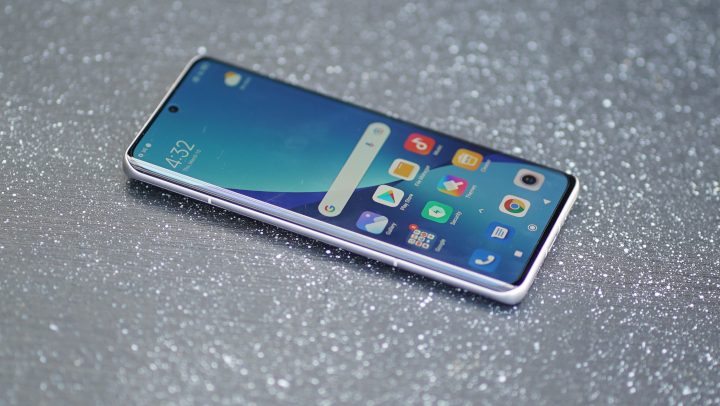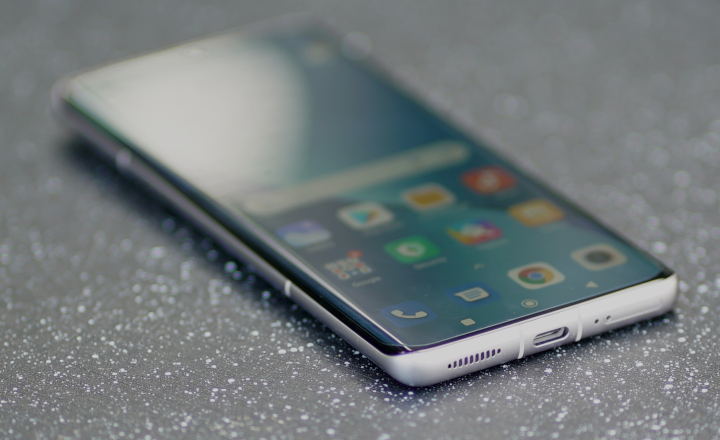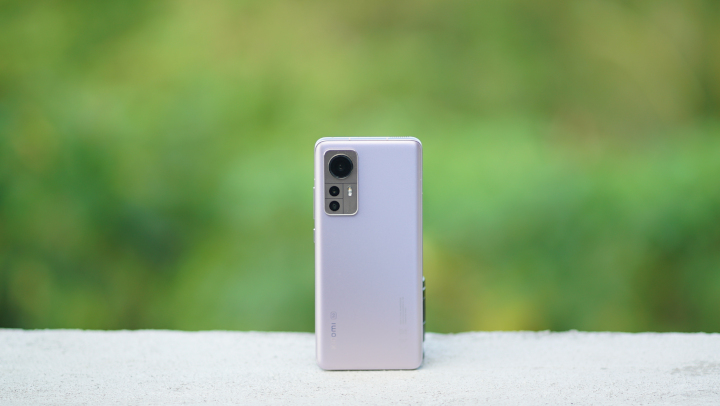Almost three months after its initial launch in China, Xiaomi has now introduced the Xiaomi 12 to the rest of the world. Of the three models in the series, the company claims the Xiaomi 12 and the Xiaomi 12 Pro as their dual flagship. Our review unit today is the Xiaomi 12, the middle sibling of the line-up.
Table of Contents
The Xiaomi 12 is actually more compact than its predecessor but we liked what they did here. At just the right size, the Xiaomi 12 fits in the hands perfectly. Even with the previous Xiaomi 11, we really fancy this model in the series. The tapered edges of the display and curved corners also help with added grip. It’s more comfortable to hold and easier to handle when making calls and sending text messages – even with one hand.

With a solid all-metal chassis, the Xiaomi 12 feels very solid and well made. Our review unit is in the blue color with the other variants are in purple or gray colors.

The usual antenna bands are found on the left side, the power button and volume rocker on the right side; the speaker grill, secondary microphone, and infra-red blaster at the top; and the USB charging port, primary speaker, microphone, and SIM card slot at the bottom.

The tray supports two nano-SIM cards with dual standby 5G capability. There’s no microSD card support here though.
At the back, we’ve got what seems like an anodized aluminum with a smooth matte finish in a light-blue tone. It’s the kind of finish that we like – not too glossy or slippery, almost smudge and fingerprint resistant, and tough enough to not easily get scratched.

The three cameras are there along with a dual-LED flash at the top left corner, some marking on the bottom right, and the Xiaomi logo on the opposite side.
The only feature we were looking forward to was the IP68 Rating for dust and water resistance. Xiaomi isn’t really fond of IP ratings and we don’t what’s keeping them from doing so.

Nevertheless, this is a solidly-built phone with a good form factor at just the right size. Just make sure to snap on the gel case that came with it so you’ll never have to find out if that metallic back panel is really scratch-resistant.
At the front, we have a 6.28-inch AMOLED DotDisplay in a full HD+ resolution. That’s 2400 x 1080 pixels or 419 pixels-per-inch packed in a 20×9 aspect ratio. It’s bright, reaching up to 1,100 nits, with support for Dolby Vision, HD10+, 120Hz AdaptiveSync and up to 480Hz Touch Sampling rate.

The screen is protected by Corning Gorilla Glass Victus and they’ve also pre-installed a very thin polycarbonate screen protector right out of the box. You’ll see some of the hairline scratches in the display in some of our shots here but those are just small nicks on the plastic screen protector and not the glass display itself. I guess we’ll just have to peel it off later and re-apply another one.

We liked the crisp, bright colors of the display. It’s vibrant, has high contrast, giving us vivid images when playing videos. Watching movies on Netflix is also better with HDR10+ support. We’re a little disappointed with the brightness level since it’s not as visible in the outdoors as we wanted it to be. Xiaomi’s decision to reduce the brightness of the display compared to the Xiaomi Mi 11 is a bit of a bummer.

The high refresh rate and even higher touch sampling rate are great for mobile gaming, especially the ones that benefit from high frame rates and fast action scenes.
This immersive visual experience is complemented by a great audio experience. Powered by a pair of symmetrical speakers, Xiaomi 12 boasts cinematic-grade stereo sound delivered with “Sound by Harman Kardon” and supports Dolby Atmos.

That IR blaster is such a nifty feature. Not many people will actually use it but in the time that we’ve been using the Xiaomi 12, it has been a lifesaver.
On our boat trip from Batangas to Caticlan, the suite room we stayed in didn’t have a remote for the TV set and the aircon. That wasn’t a problem once we paired the remote control on the Xiaomi 12.
We encountered the same problem at our hotel room in Iloilo and we never bothered asking for the remote as the Xiaomi 12 did the job just fine.
Xiaomi 12 boasts a 50MP pro-grade main camera, a 13MP ultra-wide-angle camera, and a 5MP telemacro camera.

The main camera is said to be a Sony IM766 sensor with a 6p lens (6 optical elements, plastic parts) and aperture of f/1.88, which is capable of 4K HDR10+ video recording and 8K standard video recording at either 24 or 30 frames per second.
It also features Ultra Night Video, One-click AI cinema, Xiaomi ProFocus (Motion tracking focus and Eye-tracking focus), Motion Capture, Portrait Night mode, and Portrait HDR.

The second camera has a 13-megapixel sensor with an ultra-wide lens (123° field-of-view) and f/2.4 aperture. The 3rd is a 5-megapixel telemacro camera with a 50mm equivalent focal length.
Here are sample videos we took:
There are so many other features offered by the camera — one of which we really liked is shooting in slow-mo at 1080p @ 960 frames per second.
Taking the super slow-mo shot can be quite challenging in terms of timing it perfectly. In this shot, it took us about 4 or 5 tries to get the correct effect we wanted.
The front shooter is a 32-megapixel in-display selfie camera with f/2.45 aperture and capable of 1080p HDR10+ recording, AI portrait video and selfie night-mode.

There are a lot of software AI beautification tweaks here like facial smoothing and background de-focusing as you can see in these sample selfies we took.

Over-all, we loved the camera of the Xiaomi 12. It produces sharp images with rich colors and nice deep contrasts. The camera app is very simple and easy to use.

There were so many options to choose from and many settings to dig into but the ones that really matter are there right in front of you. There were a few ones that we think are a bit gimmicky but maybe someone else might find them nice.
The Xiaomi 12 comes with Android 12–based MIUI 13 right out of the box. It’s the familiar interface we’re all gotten used to — simple but very powerful, organized yet chockfull of features, user-friendly yet highly customizable.
Xiaomi also pioneered this Memory Extension feature where you can set the phone to allocate more RAM to the system by partitioning some parts of the internal storage as virtual memory. The phones get more RAM in return and should improve the overall user experience.
Aside from the usual Google apps, MIUI 13 also has a few pre-installed apps of its own — Mi Community, Mi Remote, Mi Video, Mi Browser, Notes, ShareMe, Compass, and Scanner.
A few bloatware (like 92 and Amazon Shopping) also came preinstalled upon initial setup but it’s nothing you can just remove later.
MIUI 13 has a lot of hidden features, some of which are really useful or cool:
The in-display fingerprint sensor is fast and accurate, handles up to 5 unique fingerprints, and can even be used to determine your heart rate.
Xiaomi was trying to be the first to release a phone with a Snapdragon 8 Gen 1 chipset but someone else beat them to it. Even as a middle child — the Xiaomi 12, along with the 12 Pro – both came out packing the latest chipsets from Qualcomm.

The Snapdragon 8 Gen 1 is based 4nm power-efficient manufacturing process with an octa-core ARM Cortex processor (1x ARM Cortex-X2 @ 3.0GHz, 3x ARM Cortex-A710 @ 2.5GHz, 4x ARM Cortex-A510 @ 1.8GHz) headlined by the Qualcomm Kryo CPU, clocked up to 3.0GHz.
This is paired by an Adreno 730 GPU which Qualcomm claims has 30% better performance compared to the previous Adreno 660 integrated into the Snapdragon 888 chipset.
Add to the pile at least 8GB of LPDDR5 RAM and a UFS 3.1 internal storage and you get a great mix of very fast, powerful, and efficient hardware. The numbers from our synthetic benchmarks clearly show it.
• AnTuTu v9.3 – 881,427
• AnTuTu Storage Test v9.3.1 – 71,079, 1,807.9 MB/s (Seq. Read), 1,430.8 MB/s (Seq. Write)
• PCMark – 12,811 (Work 3.0)
• 3D Mark – 9,631 (Wild Life), 2,490 (WildLife Extreme)
• Geekbench 5 – 1,193 (Single-core), 3,487 (Multi-core)
The Xiaomi 12 packs a decent 4500mah battery and manages to last about a day to a day and a half with moderate use and the usual internet usage on social media, YouTube, and email. It can last about 6 to 8 games of Mobile Legends in Rank Mode, each game lasting about 20 to 30 minutes.

In our PCMark Battery Test, the devices lasted 11 hours and 41 minutes which is not spectacular but a bit above average.
Where the Xiaomi 12 really shines is with charging tech. You get 67W fast wired charging and 50W wireless charging. That translates to about 40 and 55 minutes from zero to full. And there’s reverse wireless charging, just in case you can’t find a wall outlet or power bank with you and you want to share your phone’s battery charge with another phone that has wireless charging.

Xiaomi’s approach here is not to achieve a very long battery life but to recharge the phone to full capacity at a much shorter time. Occasional burst charging throughout the day and you feel the battery never runs out of juice regardless of continuous use. And we agree. That’s what everyone else seems to be doing nowadays.

Xiaomi mentions that the 12 comes with its own Loop LiquidCool technology which is basically a vapor chamber that contains an evaporator, a condenser, a refill chamber, along with gas and liquid pipes to distribute heat. Maybe that’s why we haven’t really noticed the Xiaomi 12 ever having some heating issues in the few weeks we’ve used it.
Aside from the dual 5G connectivity (region-based and operator support), the Xiaomi 12 also comes with fast WiFi 6 and 6E (region-based), Bluetooth 5.2, NFC, and GPS with aGPS support (up to tri-band: GLONASS (1), BDS (3), GALILEO (2), QZSS (2), NavIC).
It’s hard to find any fault with the Xiaomi 12. There were some decisions there that seemed like a downgrade from the Xiaomi Mi 11 but those were all reasonable compromises considering that it’s a middle child and they wanted to make it as practically compact as possible.
If we had to nitpick, the lack of IP68 rating for water resistance and absence of expandable storage via microSD card slot are the two most noticeable shortcomings we could think of.

Everything else is spot on. Xiaomi has been consistent that way — nothing overkill or over-the-top — just a good balance of hardware fit for a flagship phone and pretty compelling for its price point. And mind you, there’s at least a Php10k difference between the Xiaomi 12 and many other flagship phones of this caliber.
If you want a better camera system, bigger display, and 120W HyperCharge, then there’s the Xiaomi 12 Pro for that.
The Xiaomi 12 comes in three variants — 8GB+128GB, 8GB+256GB, 12GB+256GB. The recommended retail price starts from USD749PHP 43,955INR 63,478EUR 713CNY 5,451.
Xiaomi 12 specs:
6.28-inch FHD+ (2400 x 1080) OLED display, 419ppi
120Hz refresh rate, 480Hz touch sampling rate, Dolby Vision
Corning Gorilla Glass Victus
Qualcomm Snapdragon 8 Gen 1 SoC
Adreno 730 GPU
8GB, 12GB RAM
128GB, 256GB UFS 3.1
Triple-rear cameras:
• 50MP F1.9 main
• 13MP F2.4 ultrawide
• 5MP telephoto
Dual-LED dual-tone flash
32MP front camera
Dual-SIM
5G, 4G LTE
WiFi 6+
Bluetooth 5.2
Multi-band GPS, A-GPS, GLONASS, BDS, GALILEO, QZSS, NavIC
NFC
IR blaster
USB-C
Stereo speakers w/ Harman Kardon audio
Fingerprint scanner (in-display)
MIUI 13 (Android 12)
4,500mAh battery w/ 67W wired fast charging, 50W fast wireless charging, 10W reverse wireless charging
152.7 x 69.9 x 8.2 mm (dimensions)
179 grams (weight)

YugaTech.com is the largest and longest-running technology site in the Philippines. Originally established in October 2002, the site was transformed into a full-fledged technology platform in 2005.
How to transfer, withdraw money from PayPal to GCash
Prices of Starlink satellite in the Philippines
Install Google GBox to Huawei smartphones
Pag-IBIG MP2 online application
How to check PhilHealth contributions online
How to find your SIM card serial number
Globe, PLDT, Converge, Sky: Unli fiber internet plans compared
10 biggest games in the Google Play Store
LTO periodic medical exam for 10-year licenses
Netflix codes to unlock hidden TV shows, movies
Apple, Asus, Cherry Mobile, Huawei, LG, Nokia, Oppo, Samsung, Sony, Vivo, Xiaomi, Lenovo, Infinix Mobile, Pocophone, Honor, iPhone, OnePlus, Tecno, Realme, HTC, Gionee, Kata, IQ00, Redmi, Razer, CloudFone, Motorola, Panasonic, TCL, Wiko
Best Android smartphones between PHP 20,000 - 25,000
Smartphones under PHP 10,000 in the Philippines
Smartphones under PHP 12K Philippines
Best smartphones for kids under PHP 7,000
Smartphones under PHP 15,000 in the Philippines
Best Android smartphones between PHP 15,000 - 20,000
Smartphones under PHP 20,000 in the Philippines
Most affordable 5G phones in the Philippines under PHP 20K
5G smartphones in the Philippines under PHP 16K
Smartphone pricelist Philippines 2024
Smartphone pricelist Philippines 2023
Smartphone pricelist Philippines 2022
Smartphone pricelist Philippines 2021
Smartphone pricelist Philippines 2020
Sinner Priest says:
I was reading your review and it was very nice. I would like to ask what’s your take between Samsung A73 5g 108mp vs Xioami 12 50mp camera. Which is better in term of quality? Im really torn between the 2.
Thank you
Lopager says:
Thanks for sharing